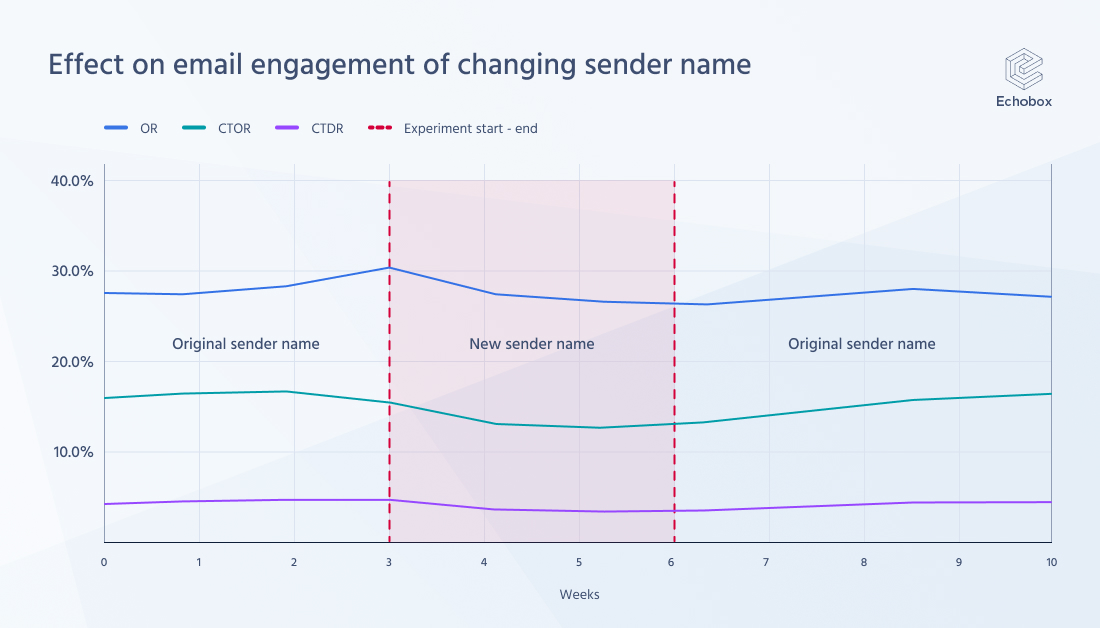Creating engaging email newsletters is one of the most effective strategies for businesses to support revenue diversification and break the hold of social media algorithms.
Often this is easier said than done. Understanding what makes your audience engage with your newsletters and other marketing communications is difficult without a mountain of resources — staff, data analysis, knowledge and insight — to draw on.
There are, however, some newsletter best practices that you should always take into account. Here, we’re going to discuss one of the most fundamental, yet often overlooked: sender names.
Think of your own inbox and the emails from businesses that you reliably open. Now ask yourself why you open them. Fundamentally, the answer is trust and routine: you trust that business to provide content that’s interesting to you, so that email becomes a part of your routine.
These two elements are just as applicable to the matter of sender names — that bit of the email that we all look at first and that for many of us, makes up our mind about whether we’re going to open it.
To understand a little more about the impact that sender names can have on email engagement and performance, we partnered with a handful of our Echobox Email users for an experiment.
We wanted to know whether changing your email sender name would have an effect on engagement rates. There may be a range of circumstances where changing your sender name might seem like a good idea. For example, perhaps you have email campaigns that were set up in the past that you feel could do with a little more tailoring? Perhaps there’s a particular campaign that would benefit from a fresh look and feel? Perhaps you are looking for ways to increase your open rates and figured experimenting with different sender names might help you optimize performance.
In theory, changing the sender name might seem a good idea. But what about in practice?
The test: What happens to email engagement if you change your email sender name?
We partnered with four Echobox Email users who kindly agreed to let us tweak their newsletter’s sender names in the interests of science. Our analysis focused on three important newsletter metrics:
- Open rate (number of unique opens divided by number of successful deliveries)
- Click-to-delivery rate (number of unique clicks divided by successful deliveries)
- Click-to-open rate (number of unique clicks divided by successful opens)
The experiment was split into three phases:
- First, a three-week period to collect data on existing open rates with existing sender names
- A second three-week period during which sender names were changed. All names were changed only once
- Finally, a month post-experiment, where we reverted to the original send name
Crucially, when considering alternate send names we followed common guidelines on industry best practice. In fact, in some senses the names we chose hewed closer to best practice than the originals. For one of the newsletters, for example, we included the first name of the newsletter’s creator to help personalize the email (i.e. “Clark from The Daily Planet”). In two other newsletters, we included emojis in the sender name (“The Daily Planet 🗞️”) and in the last case, we simply added the word “newsletter” (“The Daily Planet Newsletter”).
The results: How did changing send names affect email engagement?
The results of our study were pretty striking. In all cases, a change in sender name led to declines in all of the metrics we studied compared to pre-change levels. This indicates that changing sender names can have a significant negative impact on open rates and engagement.
Here’s an example of how email engagement metrics were impacted for one of the newsletters we studied:

Not only that, but in the month-long period after the experiment when the sender names were reverted back to their pre-experiment format, the metrics did not immediately bounce back to pre-experiment levels. Instead, the data indicated a slow rise, suggesting the metrics will return to their baseline over time.
We don’t know exactly what drove these results, but it’s a strong possibility that changing your email sender name can have a negative impact on the perceived trustworthiness of your newsletter. And once this trust is lost, it seems very difficult to regain.
The takeaway: Changing your sender name can harm your email’s engagement
Habit formation is the ultimate goal of any newsletter strategy, increasing your brand’s value to your audience and establishing trust. Our experiment shows that changing your email sender name can have an immediate negative impact. None of the metrics studied returned immediately to their pre-experiment rates right after the sender names were reverted to their original versions, although the trend displayed in the data indicates they will over time. This shows that trust is a significant element in explaining these results. When sender names changed, the number of people opening and clicking immediately declined. Once these changes were reversed, people began to return to opening and clicking, but not straight away. These results highlight the importance of coming up with a comprehensive strategy for your newsletters before you start to send them. Carefully select a sender name, and stick to it!
It’s important to note that changing and adapting elements of your newsletters isn’t a bad idea. Optimizing and personalizing elements within your email can produce significant benefits that can only be realized by incremental experimentation. But when it comes to sender names, change is not good for email engagement rates.
Working to build trust in your newsletters is a long process, so don’t squander it.



